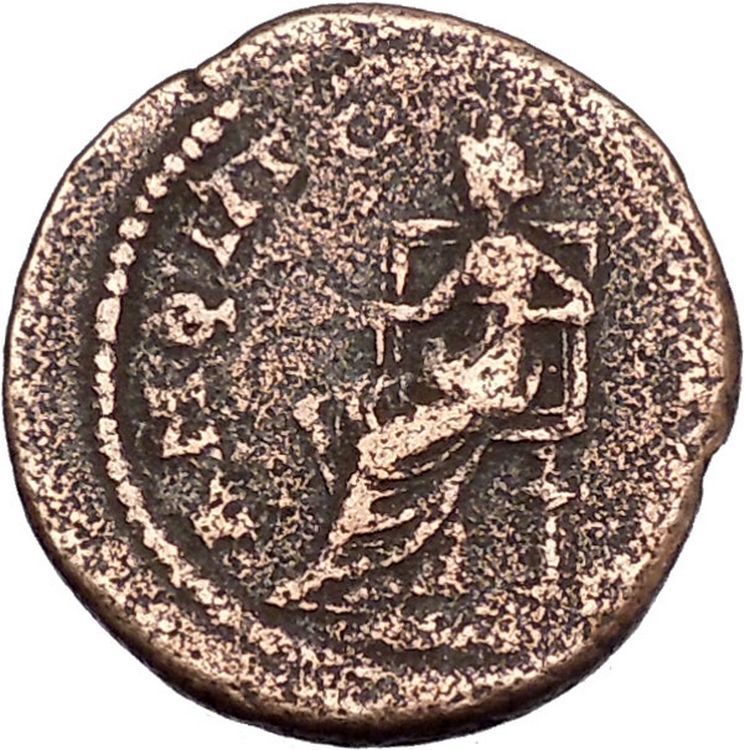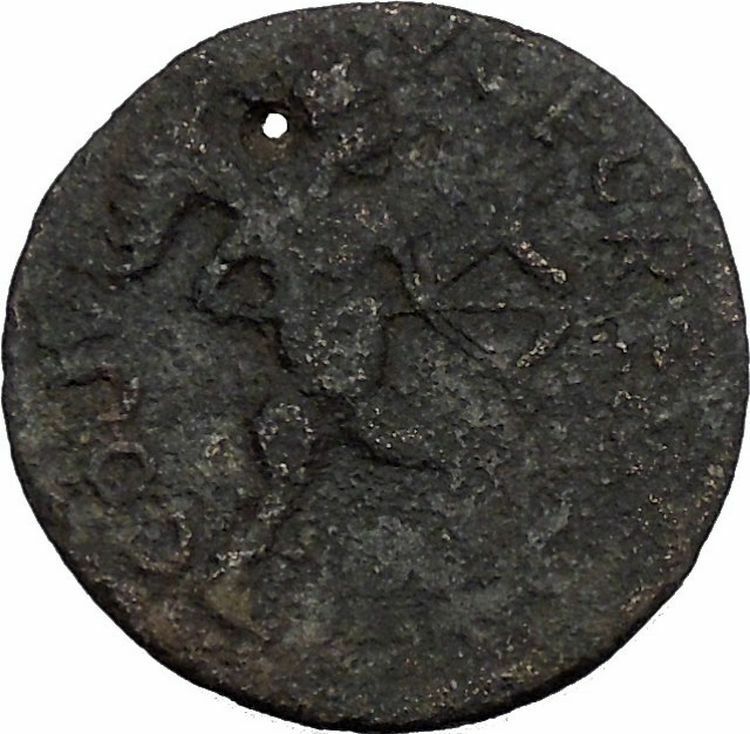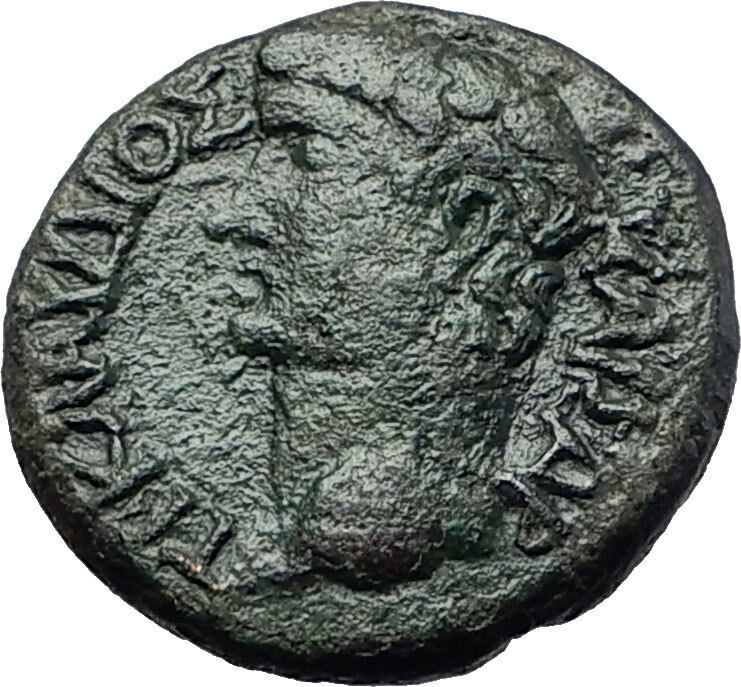|
Trajan
–
Roman Emperor
: 98-117 A.D. –
Bronze 25mm (16.42 grams) of
Thessalonica
in
Macedonia
Reference: Varbanov 4292 corr.; SNG Cop 412.
KAICAP TRAIANOC, radiate head right.
ΘЄCCΑΛΟΝΙΚЄWΝ,
Nike
advancing right, holding wreath and palm.
You are bidding on the exact item pictured,
provided with a Certificate of Authenticity and Lifetime Guarantee of
Authenticity.
In
Greek mythology
,
Nike was a
goddess
who personified
victory
, also known as the Winged Goddess of
Victory. The Roman equivalent was
Victoria
. Depending upon the time of various
myths, she was described as the daughter of
Pallas
(Titan) and
Styx (Water) and the sister of
Kratos
(Strength),
Bia
(Force), and
Zelus
(Zeal). Nike and her siblings were close
companions of Zeus
, the dominant deity of the
Greek pantheon
. According to classical (later)
myth, Styx brought them to Zeus when

the
god was assembling allies for the
Titan War
against the older deities. Nike
assumed the role of the divine
charioteer
, a role in which she often is
portrayed in Classical Greek art. Nike flew around battlefields rewarding the
victors with glory and fame.
Nike is seen with wings in most statues and paintings. Most other winged
deities in the Greek pantheon had shed their wings by Classical times. Nike is
the goddess of strength, speed, and victory. Nike was a very close acquaintance
of Athena
, and is thought to have stood in
Athena’s outstretched hand in the statue of Athena located in the Parthenon.
Nike is one of the most commonly portrayed figures on Greek coins.
Names stemming from Nike include amongst others:
Nicholas
, Nicola, Nick, Nikolai, Nils, Klaas,
Nicole, Ike, Niki, Nikita, Nika, Niketas, and Nico.
The city was founded around
315 BC
by the
King
Cassander of Macedon
, on or near the site of the ancient town of
Therma
and
twenty-six other local villages. He named it after his wife
Thessalonike
, a half-sister of
Alexander the Great
. She gained her name (“victory of Thessalians”: Gk
nikē
“victory”) from her father,
Philip II
, to commemorate her birth on the day of his gaining a victory over
the
Phocians
, who were defeated with the help of
Thessalian
horsemen, the best in Greece at that time. Thessaloniki developed
rapidly and as early as the
2nd
century BC
the first walls were built, forming a large square. It was an
autonomous part of the Kingdom of
Macedon
, with its own parliament where the King was represented and could
interfere in the city’s domestic affairs.
Roman
era
After the fall of the kingdom of Macedon in
168 BC
,
Thessalonica became a city of the
Roman Republic
. It grew to be an important trade-hub located on the
Via
Egnatia
, the
Roman road
connecting
Byzantium
(later
Constantinople
), with
Dyrrhachium
(now Durrës
in
Albania
), and
facilitating trade between Europe and Asia. The city became the capital of one
of the four Roman districts of Macedonia; it kept its privileges but was ruled
by a praetor
and had a Roman garrison, while for a short time in the
1st
century BC
, all the Greek provinces came under Thessalonica (the Latin form
of the name). Due to the city’s key commercial importance, a spacious harbour
was built by the Romans, the famous Burrowed Harbour (Σκαπτός Λιμήν) that
accommodated the town’s trade up to the eighteenth century; later, with the help
of silt deposits from the river
Axios
, it was
reclaimed as land and the port built beyond it. Remnants of the old harbour’s
docks can be found in the present day under Odos Frangon Street, near the
Catholic Church.
Thessaloniki’s
acropolis
,
located in the northern hills, was built in
55 BC
after
Thracian
raids in the city’s outskirts, for security reasons.
The city had a
Jewish
colony, established during the
first
century
, and was to be an early centre of
Christianity
. On his second missionary journey,
Paul
of Tarsus
, born a Hellenized Israelite, preached in the city’s synagogue,
the chief synagogue of the Jews in that part of Thessaloniki, and laid the
foundations of a church. Other Jews opposed to Paul drove him from the city, and
he fled to
Veroia
. Paul wrote two of his
epistles
to the Christian community at Thessalonica, the
First Epistle to the Thessalonians
and the
Second Epistle to the Thessalonians
.
Thessaloníki acquired a patron saint,
St. Demetrius
, in 306. He is credited with a number of miracles that saved
the city, and was the Roman
Proconsul
of Greece under the anti-Christian emperor
Maximian
,
later martyred at a Roman prison where today lies the
Church of St. Demetrius
, first built by the Roman sub-prefect of
Illyricum
Leontios in 463. Other important remains from this period include
the
Arch and Tomb of Galerius
, located near the centre of the modern city.
Marcus Ulpius Nerva Traianus, commonly known as
Trajan (18 September, 53 – 8 August, 117), was a
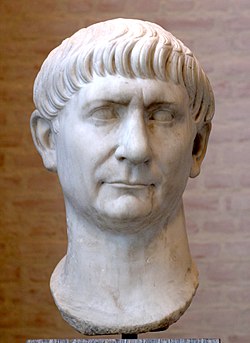 Roman Roman
Emperor who reigned from AD 98 until his death in AD 117. Born
Marcus Ulpius Traianus into a non-patrician
family in the
Hispania Baetica
province (modern day
Spain
), Trajan rose to prominence during the
reign of emperor
Domitian
, serving as a general in the
Roman army
along the
German frontier
, and successfully crushing the
revolt of
Antonius Saturninus
in 89. On September 18, 96,
Domitian was succeeded by
Marcus Cocceius Nerva
, an old and childless
senator who proved to be unpopular with the army. After a brief and tumultuous
year in power, a revolt by members of the
Praetorian Guard
compelled him to adopt the
more popular Trajan as his heir and successor. Nerva died on January 27, 98, and
was succeeded by his adopted son without incident.
As a civilian administrator, Trajan is best known for his
extensive public building program, which reshaped the city of
Rome and left multiple enduring landmarks such as
Trajan’s Forum
,
Trajan’s Market
and
Trajan’s Column
. It was as a military commander
however that Trajan celebrated his greatest
triumphs
. In 101, he launched a
punitive expedition
into the kingdom of
Dacia
against king
Decebalus
, defeating the Dacian army near
Tapae
in 102, and finally conquering Dacia
completely in 106. In 107, Trajan pushed further east and annexed the
Nabataean kingdom
, establishing the province of
Arabia Petraea
. After a period of relative
peace within the Empire, he launched his final campaign in 113 against
Parthia
, advancing as far as the city of
Susa in 116, and expanding the Roman Empire to its greatest extent.
During this campaign Trajan was struck by illness, and late in 117, while
sailing back to Rome, he died of a
stroke
on
August 9
, in the city of
Selinus
. He was
deified
by the Senate and his ashes were laid
to rest under
Trajan’s Column
. He was succeeded by his
adopted son (not having a biological heir)
Publius Aelius Hadrianus
—commonly known as
Hadrian.
As an emperor, Trajan’s reputation has endured – he is one of
the few rulers whose reputation has survived the scrutiny of nineteen centuries
of history. Every new emperor after him was honoured by the Senate with the
prayer felicior Augusto, melior Traiano, meaning “may he be luckier than
Augustus
and better than Trajan”. Among
medieval
Christian theologians, Trajan was
considered a
virtuous pagan
, while the 18th century
historian
Edward Gibbon
popularized the notion of the
Five Good Emperors
, of which Trajan was the
second.
Early life and rise to power
Trajan was born on September 18, 53 in the Roman province of
Hispania Baetica
(in what is now
Andalusia
in modern Spain), a province that was
thoroughly Romanized and called southern Hispania, in the city of
Italica
, where the
Italian
families were paramount. Of
Italian
stock himself, Trajan is frequently but
misleadingly designated the first provincial emperor.
Trajan was the son of
Marcia
and
Marcus Ulpius Traianus
, a prominent
senator
and general from the famous
Ulpia
gens.
Trajan himself was just one of many well-known Ulpii in a line that continued
long after his own death. His elder sister was
Ulpia Marciana
and his niece was
Salonina Matidia
. The
patria
of the Ulpii was
Italica
, in Spanish Baetica, where their
ancestors had settled late in the third century B.C. This indicates that the
Italian origin was paramount, yet it has recently been cogently argued that the
family’s ancestry was local, with Trajan senior actually a Traius who was
adopted into the family of the Ulpii.
As a young man, he rose through the ranks of the
Roman army
, serving in some of the most
contentious parts of the Empire’s frontier. In 76–77, Trajan’s father was
Governor
of
Syria
(Legatus
pro praetore Syriae), where Trajan himself remained as
Tribunus
legionis. Trajan was nominated as
Consul
and brought
Apollodorus of Damascus
with him to
Rome around 91. Along the
Rhine River
, he took part in the Emperor
Domitian
‘s wars while under Domitian’s
successor, Nerva
, who was unpopular with the army and
needed to do something to gain their support. He accomplished this by naming
Trajan as his adoptive son and successor in the summer of 97. According to the
Augustan History
, it was the future Emperor
Hadrian
who brought word to Trajan of his
adoption. When Nerva died on January 27, 98, the highly respected Trajan
succeeded without incident.
His
reign
The new Roman emperor was greeted by the people of Rome with
great enthusiasm, which he justified by governing well and without the
bloodiness that had marked Domitian’s reign. He freed many people who had been
unjustly imprisoned by Domitian and returned a great deal of private property
that Domitian had confiscated; a process begun by Nerva before his death. His
popularity was such that the
Roman Senate
eventually bestowed upon Trajan
the honorific
of optimus, meaning “the
best”.
Dio Cassius
, sometimes known as Dio, reveals
that Trajan drank heartily and was
involved with boys
. “I know, of course, that he
was devoted to boys and to wine, but if he had ever committed or endured any
base or wicked deed as the result of this, he would have incurred censure; as it
was, however, he drank all the wine he wanted, yet remained sober, and in his
relation with boys he harmed no one.” This sensibility was one that influenced
his governing on at least one occasion, leading him to favour the king of Edessa
out of appreciation for his handsome son: “On this occasion, however,
Abgarus
, induced partly by the persuasions of
his son Arbandes, who was handsome and in the pride of youth and therefore in
favour with Trajan, and partly by his fear of the latter’s presence, he met him
on the road, made his apologies and obtained pardon, for he had a powerful
intercessor in the boy.”
Dacian
Wars
It was as a military commander that Trajan is best known to
history, particularly for his conquests in the
Near East
, but initially for the two wars
against Dacia
— the reduction to client kingdom
(101-102), followed by actual incorporation to the Empire of the trans-Danube
border kingdom of Dacia—an area that had troubled Roman thought for over a
decade with the unfavourable (and to some, shameful) peace negotiated by
Domitian
‘s ministers In the first war c.
March–May 101, he launched a vicious attack into the kingdom of
Dacia
with four legions, crossing to the
northern bank of the
Danube River
on a stone bridge he had built,
and defeating the Dacian army near or in a
mountain pass
called
Tapae
(see
Second Battle of Tapae
). Trajan’s troops were
mauled in the encounter, however and he put off further campaigning for the year
to heal troops, reinforce, and regroup.
During the following winter, King
Decebalus
launched a counter-attack across the
Danube
further downstream, but this was
repulsed. Trajan’s army advanced further into Dacian territory and forced King
Decebalus to submit to him a year later, after Trajan took the Dacian
capital/fortress of
Sarmizegethusa
. The Emperor Domitian had
campaigned against
Dacia from 86 to 87
without securing a decisive
outcome, and Decebalus had brazenly flouted the terms of the peace (89 AD) which
had been agreed on conclusion of this campaign.
Trajan now returned to Rome in triumph and was granted the
title Dacicus Maximus. The victory was celebrated by the
Tropaeum Traiani
. Decebalus though, after being
left to his own devices, in 105 undertook an invasion against Roman territory by
attempting to stir up some of the tribes north of the river against her.
Trajan took to the field again and after building with the
design of
Apollodorus of Damascus
his
massive bridge over the Danube
, he conquered
Dacia completely in 106. Sarmizegethusa was destroyed,
Decebalus
committed
suicide
, and his severed head was exhibited in
Rome on the steps leading up to the
Capitol
. Trajan built a new city, “Colonia
Ulpia Traiana Augusta Dacica Sarmizegetusa”, on another site than the previous
Dacian Capital, although bearing the same full name, Sarmizegetusa. He resettled
Dacia with Romans and annexed it as a province of the Roman Empire. Trajan’s
Dacian campaigns benefited the Empire’s finances through the acquisition of
Dacia’s gold mines. The victory is celebrated by
Trajan’s Column
.
Expansion
in the East
At about the same time
Rabbel II Soter
, one of Rome’s client kings,
died. This event might have prompted the annexation of the
Nabataean kingdom
, although the manner and the
formal reasons for the annexation are unclear. Some epigraphic evidence suggests
a military operation, with forces from
Syria
and
Egypt
. What is clear, however, is that by 107,
Roman legions were stationed in the area around
Petra
and
Bostra
, as is shown by a papyrus found in
Egypt. The empire gained what became the province of
Arabia Petraea
(modern southern
Jordan
and north west
Saudi Arabia
).
Period
of peace
The next seven years, Trajan ruled as a civilian emperor, to
the same acclaim as before. It was during this time that he corresponded with
Pliny the Younger
on the subject of how to deal
with the
Christians
of
Pontus
, telling Pliny to leave them alone
unless they were openly practicing the religion. He built several new buildings,
monuments and roads in
Italia
and his native
Hispania
. His magnificent complex in Rome
raised to commemorate his victories in
Dacia
(and largely financed from that
campaign’s loot)—consisting of a
forum
,
Trajan’s Column
, and Trajan’s Market still
stands in Rome today. He was also
a prolific builder of triumphal arches
, many of
which survive, and rebuilder of roads (Via
Traiana and
Via Traiana Nova
).
One notable act of Trajan was the hosting of a three-month
gladiatorial
festival in the great
Colosseum
in Rome (the precise date of this
festival is unknown). Combining chariot racing, beast fights and close-quarters
gladiatorial bloodshed, this gory spectacle reputedly left 11,000 dead (mostly
slaves and criminals, not to mention the thousands of ferocious beasts killed
alongside them) and attracted a total of five million spectators over the course
of the festival.
Another important act was his formalisation of the
Alimenta, a welfare program that helped orphans and poor children throughout
Italy. It provided general funds, as well as food and subsidized education. The
program was supported initially by funds from the Dacian War, and then later by
a combination of estate taxes and philanthropy.[13].
Although the system is well documented in literary sources and contemporary
epigraphy, its precise aims are controversial and have generated considerable
dispute between modern scholars: usually, it’s assumed that the programme
intended to bolster citzen numbers in Italy. However, the fact that it was
subsidized by means of interest payments on loans made by landowners restricted
it to a small percentage of potential welfare recipients (Paul
Veyne has assumed that, in the city of
Veleia
, only one child out of ten was an actual
beneficiary) – therefore, the idea, advanced by
Moses I. Finley
, that the whole scheme was at
most a form of random charity, a mere imperial benevolence[14].
Maximum
extent of the Empire

The extent of the Roman Empire under Trajan (117)
In 113, he embarked on his last campaign, provoked by
Parthia
‘s decision to put an unacceptable king
on the throne of Armenia
, a kingdom over which the two great
empires had shared
hegemony
since the time of
Nero some fifty years earlier. Some modern historians also attribute
Trajan’s decision to wage war on Parthia to economic motives: to control, after
the annexation of Arabia, Mesopotamia and the coast of the Persian Gulf, and
with it the sole remaining receiving-end of the Indian trade outside Roman
control – an attribution of motive other historians find absurd, as seeing a
commercial motive in a campaign triggered by the lure of territorial annexation
and prestige – by the way, the only motive for Trajan’s actions ascribed by Dio
Cassius in his description of the events. Other modern historians, however,
think that Trajan’s original aim was quite modest: to assure a more defensible
Eastern frontier for the Roman Empire, crossing across Northern Mesopotamia
along the course of the river
Khabur
in order to offer cover to a Roman
Armenia.
Trajan marched first on Armenia, deposed the
Parthian-appointed king (who was afterwards murdered while kept in the custody
of Roman troops in an unclear incident) and annexed it to the Roman Empire as a
province, receiving in passing the acknowledgement of Roman hegemony by various
tribes in the Caucasus and on the Eastern coast of the Black Sea – a process
that kept him busy until the end of 114].
The cronology of subsequent events is uncertain, but it’s generally believed
that early in 115 Trajan turned south into the core Parthian hegemony, taking
the Northern Mesopotamian cities of
Nisibis
and
Batnae
and organizing a province of
Mesopotamia
in the beginning of 116, when coins
were issued announcing that Armenia and Mesopotamia had been put under the
authority of the Roman people.
In early 116, however, Trajan began to toy with the conquest
of the whole of Mesopotamia, an overambitious goal that eventually backfired on
the results of his entire campaign: One Roman division crossed the
Tigris
into
Adiabene
, sweeping South and capturing
Adenystrae
; a second followed the river South,
capturing Babylon
; while Trajan himself sailed down the
Euphrates
, then dragged his fleet overland into
the Tigris, capturing
Seleucia
and finally the Parthian capital of
Ctesiphon
. He continued southward to the
Persian Gulf
, receiving the submission of
Athambelus, the ruler of
Charax
, whence he declared Babylon a new
province of the Empire, sent the Senate a laurelled letter declaring the war to
be at a close and lamented that he was too old to follow in the steps of
Alexander the Great
and reach the distant
India
itself. A province of
Assyria
was also proclaimed, apparently
covering the territory of Adiabene, as well as some measures seem to have been
considered about the fiscal administration of the Indian trade.
However, as Trajan left the Persian Gulf for Babylon – where
he intended to offer sacrifice to Alexander in the house where he had died in
323 B.C.- a sudden outburst of Parthian resistance, led by a nephew of the
Parthian king, Sanatrukes, imperilled Roman positions in Mesopotamia and
Armenia, something Trajan sought to deal with by forsaking direct Roman rule in
Parthia proper, at least partially: later in 116, after defeating a Parthian
army in a battle where Sanatrukes was killed and re-taking Seleucia, he formally
deposed the Parthian king
Osroes I
and put his own puppet ruler
Parthamaspates
on the throne. That done, he
retreated North in order to retain what he could of the new provinces of Armenia
and Mesopotamia.
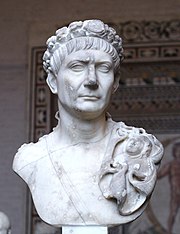
Bust of Trajan,
Glyptothek
,
Munich
.
It was at this point that Trajan’s health started to fail
him. The fortress city of
Hatra
, on the
Tigris
in his rear, continued to hold out
against repeated Roman assaults. He was personally present at the
siege
and it is possible that he suffered a
heat stroke while in the blazing heat. Shortly afterwards, the
Jews inside the Eastern Roman Empire rose up in rebellion once more,
as did the people of Mesopotamia. Trajan was forced to withdraw his army in
order to put down the revolts. Trajan saw it as simply a temporary setback, but
he was destined never to command an army in the field again, turning his Eastern
armies over to the high ranking legate and governor of Judaea,
Lusius Quietus
, who in early 116 had been in
charge of the Roman division who had recovered Nisibis and
Edessa
from the rebels; Quietus was promised
for this a consulate in the following year – when he was actually put to death
by Hadrian
, who had no use for a man so committed
to Trajan’s aggressive policies.
Early in 117, Trajan grew ill and set out to sail back to
Italy. His health declined throughout the spring and summer of 117, something
publicy acknowledged by the fact that a bronze bust displayed at the time in the
public baths of
Ancyra
showed him clearly aged and edemaciated.
By the time he had reached Selinus in
Cilicia
which was afterwards called
Trajanopolis, he suddenly died from
edema
on August 9. Some say that he had adopted
Hadrian
as his successor, but others that it
was his wife
Pompeia Plotina
who hired someone to
impersonate him after he had died.
Hadrian
, upon becoming ruler, recognized the
abandonment of Mesopotamia and restored Armenia – as well as
Osroene
– to the Parthian hegemony under Roman
suzerainty – a telling sign the Roman Empire lacked the means for pursuing
Trajan’s overambitious goals. However, all the other territories conquered by
Trajan were retained. Trajan’s ashes were laid to rest underneath Trajan’s
column, the monument commemorating his success.
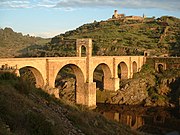
The
Alcántara Bridge
, widely hailed as
a masterpiece of
Roman engineering
.
Building
activities
Trajan was a prolific builder in Rome and the provinces, and
many of his buildings were erected by the gifted architect
Apollodorus of Damascus
. Notable structures
include
Trajan’s Column
,
Trajan’s Forum
,
Trajan’s Bridge
,
Alcántara Bridge
, and possibly the
Alconétar Bridge
. In order to build his forum
and the adjacent brick market that also held his name Trajan had vast areas of
the surrounding hillsides leveled.
Trajan’s
legacy
Unlike many lauded rulers in history, Trajan’s reputation has
survived undiminished for nearly nineteen centuries.
Ancient sources on Trajan’s personality and accomplishments
are unanimously positive. Pliny the younger, for example, celebrates Trajan in
his panegyric as a wise and just emperor and a moral man.
Dio Cassius
admits Trajan had vices like heavy
drinking and sexual involvement with boys, but added that he always remained
dignified and fair. The
Christianisation
of Rome resulted in further
embellishment of his legend: it was commonly said in
medieval
times that
Pope Gregory I
, through divine intercession,
resurrected Trajan from the dead and baptized him into the Christian faith. An
account of this features in the
Golden Legend
.
Theologians, such as
Thomas Aquinas
, discussed Trajan as an example
of a virtuous pagan. In
the Divine Comedy
,
Dante
, following this legend, sees the spirit
of Trajan in the Heaven of
Jupiter
with other historical and mythological
persons noted for their justice.
He also features in
Piers Plowman
. An episode, referred to as
the
justice of Trajan
was reflected in several art
works.
In the 18th Century King
Charles III of Spain
comminsioned
Anton Raphael Mengs
to paint The Triumph of
Trajan on the ceiling of the banqueting-hall of the
Royal Palace of Madrid
– considered among the
best work of this artist.
“Traian” is used as a male first name in present-day
Romania
– among others, that of the country’s
incumbent president,
Traian Băsescu
.
|






 Roman
Roman



